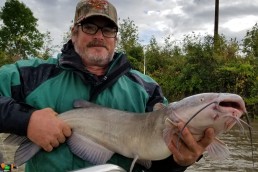Locating Catfish: Look for Nature’s Signs
SHARE THIS POST
Brad Durick finds that keeping good notes of anything that triggered a pattern, uptick or downtick in fish activity will serve to help you locate catfish again and again.
Everything works in unison as the seasons go on. Over the years, I have learned much about how the season progresses, such as how things like trees can tell you what the fish are doing; how the river tells you where the holes are; and how other animals can give an indication of how fishing will be.
Watch the sky
If the sun is shining and there is not a cloud in the sky, you are probably fishing under a high-pressure system. If you have clouds and it’s partly sunny, it is probably a falling barometer.
On the clearer days, you may want to consider looking for fish in deeper water, while on cloudy days, the fish can get more aggressive as they are preparing for a weather event. This is a time when you can fish more aggressively until the front passes.
Obviously, if there are low clouds and rain, a front has pushed through. Sometimes, rain will turn catfish on if there was not a big low-pressure system attached to it. When this happens, other than some minor discomfort from fishing in the rain, the bite can be outstanding.
If its raining on the back side of a major low-pressure system, however, fishing for catfish may be poor. This is a case where the sky will tell you the conditions, but you will need to watch the wind to get the real story to know what is happening.
Pay attention to the wind
Wind can tell you a lot. Wind can indicate fronts and barometric trends. If the wind is out of the same direction for more than three days, the weather is stable and fishing should be good. Fish will tend to be more aggressive, so fish in more aggressive spots.
If the wind is from the south/southeast, the barometer is lightly falling and generally the air is warmer. If the wind turns from the south to west to northwest over the course of a few minutes to a day, a front has pushed through. When it comes around to the northwest, the barometer has bottomed out and is back on the rise. Catfish tend to slow down and move out of current to resting areas. Slow your fishing down when this front moves through.
If the wind is from the northeast for an extended period of time, you can be rest assured there is something on the way. East or northeast winds tend to make fishing less than great, and almost always have a storm or rain event attached to them.
Are you enjoying this post?
You can be among the first to get the latest info on where to go, what to use and how to use it!
Notice the animals on the bank
Animals seem to operate in unison. Watch the bank to see what other animals are doing. Deer in particular follow similar patters to catfish, especially when there are storms in the forecast.
If you are noticing deer out all day, the catfish are usually on the feed as well. Catfish and deer both roam and feed in the morning and evening, but when there is a negative weather event on the way, both of them will feed aggressively all day long up until the storm hits and they take cover.
Holes and seams on the surface
If you look at a river on a flat-calm day, you can you can begin see how the current breaks and holes are laid out by what the surface of the water is telling you. For the seam on the main channel, you can usually see a small boil line formed where the drop off occurs.
When there is a hole, the seam sometimes will move off the side where the hole opens up wider, or it will flatten out and be more difficult to see. This means that the water is dropping into the hole and the surface line cannot be maintained. At the back of the hole, you will see the current seam form up again.
Sometimes you will see a random boil on the surface. This is telling you that there is something under the water. It may be a tree or rock or some other element of structure. This tells you that there is something you could hit with the boat, or that there is something that may hold a fish. It is up to you to figure out which one.
Pay attention to your surroundings, keep an eye on the sky, watch the water and watch the animals. These are old-school techniques that can quickly tell you what is going on with the fish. Learning some of these basic observations will make you a better catfish angler overall.
If you want to learn other ways that nature helps us have the most productive fishing, look to the pages of MidWest Outdoors, available the first full week of each month at the newsstand or by subscribing on our website.
MWO
SHARE THIS POST
You may also like...
Nothing found.
Did you enjoy this post?
You can be among the first to get the latest info on where to go, what to use and how to use it!
Brad Durick
Captain Brad Durick is a nationally recognized catfish guide, seminar speaker, and author of the books Cracking the Channel Catfish Code and Advanced Catfishing Made Easy. For more information: redrivercatfish.com or facebook.com/braddurickoutdoors.
